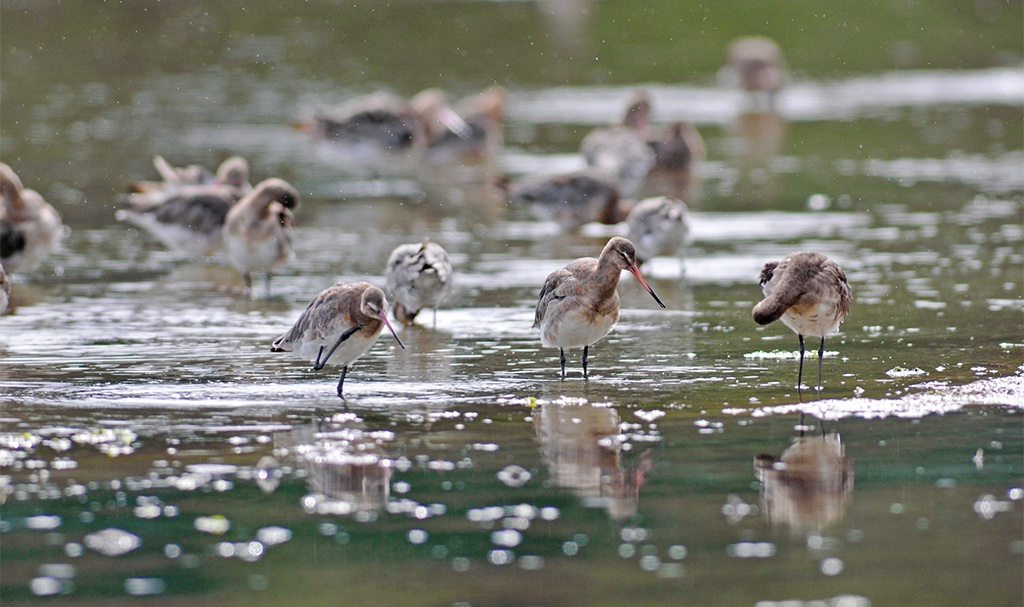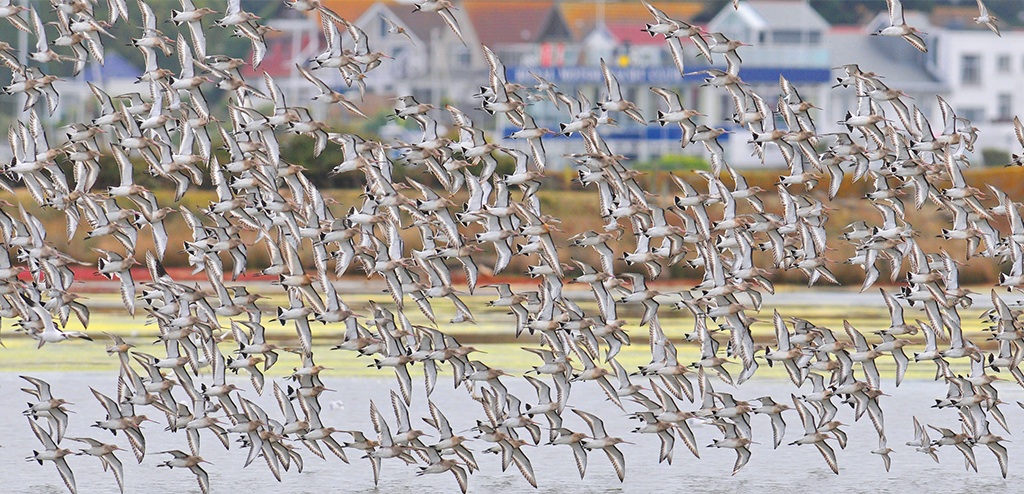Come rain or shine, once a month during the non-breeding season, 3,000 counters stand along the water margins of the 2,000 WeBS sites in Britain, and count the ducks and waders in synchrony. It’s a massive undertaking, generating what is an industrial quantity of data. Over the last decade, Andy Musgrove and his team at the BTO turned this survey round from something that was producing results three years late, to one that is bang on time, and now the challenge is to repeat that year after year. Starting in 2007 they changed WeBS from an entirely paper-based survey to one that is now predominantly online. Just to add to the challenge, they aim to produce a full national report 12 months after the end of the last count.
I’m hoping now that I have you imagining a group of bird surveyors co-ordinated in perfect harmony, like a flock of Dunlin veering across the sky… and it’s true if you add a little group of stragglers trying to catch up. We are those stragglers. All over Britain, bird counters go out at the same time, at high tide. Here in Poole, however, we go out at low tide.
Traditionally, this is because where other sites have easily visible roosts, in Poole Harbour and all along the Solent the roosts are on Spartina-covered islands. Consequently, you can’t see the waders hunkered down in the grass. That’s how it used to be, but the Spartina is dying. Its lightning-fast colonisation (described as hybrid vigour) peaked in 1924, and between then and 2004 the amount of mud flat covered by Spartina within the harbour halved. The decline of Spartina continues, but we still go out at low tide.
Well, we hope it’s going to be low tide. We get a tidal surge caused when the Isle of Wight delays a body of water that rushes in through the harbour mouth about 40 minutes after the normal high tide, just when everything else is trying to rush out. Called the ‘cork effect’, this creates a double high tide both here and at Christchurch harbour.
Because Poole Harbour is a large shallow basin of water, high-pressure weather systems can affect the height of the tide. In addition, strong westerly wind can push the water out while an easterly can hold the water in. Just to add to the confusion, the narrow harbour mouth creates a delay as the water passes between the islands where it slows down. All this means that high tide at the harbour entrance can be up to an hour and forty minutes before high tide at Wareham. In other words, you can be watching waders at low tide at Brand’s Bay at 13:00 while a friend at Middlebere has to wait till 14:40 for the same amount of mud.
That’s assuming that the water has covered the mud at Middlebere at all. The shallow nature of the harbour means that higher parts of the harbour seabed like Middlebere can be left exposed at high tide. It’s not just the shallows. The deeps also cause problems. To count the waders in Lytchett Bay, you have to be there at the magic moment when the mud is uncovered but the creeks are full, otherwise all the waders have disappeared into the deep channels and can’t be seen. Pity the amateur WeBS organiser trying to fit in an ideal tide on a Sunday after church.
I had only just got to grips with the idea of the tidal range being greater when the earth, moon and sun are in alignment (spring tides twice a month) and, conversely, reduced when the same heavenly bodies are furthest out of line (neap tides), when I learnt about our local amphidrome. Like a mythical destination from a pirate film, tidal systems rotate around amphidromes, and consequently the tide neither rises nor falls at the centre of one. This has to do with the Coriolis effect, which most famously determines the direction water spirals down a drain (anti-clockwise in the northern hemisphere). The closest major amphidromes to Poole are in the Atlantic and North Sea (halfway between Holland and Norfolk), but there is a minor one on the edge of the New Forest. Obviously there’s no tide in a forest, but if water did cover it the tide there would never come in or go out. All the smaller harbours along the Solent, like Christchurch, have a tiny tidal range because of their proximity to the amphidrone.
Across the channel at Cherbourg the tidal range is 12 metres, so the tide goes a long, long way out there, but inside Poole Harbour the range is only two metres between high and low water during spring tides, and as little as 30 cm during neap tides. All this means that for 16 out of 24 hours, the mud in Poole is submerged. Great for the small boats of bait draggers who chug round and round in circles dragging the worms up to sell to fisherman, but a bit tougher on the waders.
All the talk of sea levels rising a meter because of global warming melting ice in the Arctic means that our pub conversations are often about the possible consequences for Poole Harbour, and especially about the state of repair of the sea wall around Brownsea lagoon.
While water levels have been predicted to rise around 29 cm on the southwest coast by 2050 (UK government 2010), there has been little sign of this so far. Over the past 25 years, we have only seen a rise of a centimetre inside Poole Harbour. With the effect of the New Forest amphidrome, dredging of main channels, long shore drift, silt from rivers, and dramatic changes in the distribution of Spartina it is difficult for us to agree about its significance. All the studies show that ice on Greenland is melting at an unprecedented rate. While resulting rises in water levels are fairly slow at present, they are expected to be much faster by around 2025.
Down at the pub I suggested that when world water levels have risen dramatically by a meter, the close proximity of the New Forest amphidrome will mean that we only get a couple of centimetres while the parts of France with a huge tidal range will disappear in a biblical flood. This idea got me a few hearty English laughs but as amphidromes have no effect on general increases in sea level, only its tidal range, the idea was soon rubbished.

Icelandic Black-tailed Godwits Limosa limosa islandica, Poole, Dorset, 27 August 2011 (René Pop)
At present, the shoreline policy within Poole Harbour is to remove sea defences. Ian Alexander, a birder and pub irregular, works for Natural England, one of the agencies responsible for this policy. Cyril Diver’s natural vision for our area lives on in Ian and his colleagues, and as he talks you can feel the passion he has for this countryside. He takes climate change seriously, and when he’s not striding round Bestwall working out exactly what will be inundated when water levels rise, he can be seen in the local Waitrose removing the unwanted plastic packaging from his purchases with his penknife. Predicting the effects of climate change is one very big step beyond weather forecasting, and Ian hits the nail on the head when he says: “You can’t plan for climate change, Mark, only prepare.”

Black-tailed Godwits Limosa limosa and other waders, Brownsea lagoon, Dorset, 4 October 2009 (Claire Lodge)
OK, it’s time I came clean, here tucked deep inside the book. Having watched Poole and Bournemouth councils spend millions creating artificial reefs, and pumping sand back onto the popular beaches, there’s a similar project I’d like to see adopted. I like the way the Dutch look at things. Their dykes reclaim the sea to create reserves that in turn hold masses of singing Marsh Warblers. Now you’re talking! I prefer a vision of Poole where we create dykes to control flooding, creating new bird habitats while protecting homes. In this utopia, two new dykes would be built between Brownsea and Furzey, forming another huge lagoon. Alternatively, linking Furzey and Green Islands with dykes and a lagoon would effectively recreate ‘South Island’, which existed until Iron Age times (Dyer & Darvill 2010).
I suggested this to Ian and he frowned. “Hardly preserving a natural England, Mark.” I pointed out that it was interesting how aware he was of the chaotic reality of Poole Harbour’s nature, and yet through his work and training he maintained an ‘unspoilt’ and tranquil vision for others. He replied: “The pace of present change is high by most historic standards and we are changing so many things simultaneously. It seems to me to be a fairly irresponsible experiment.”
One of the reasons why counting the waders in the harbour is so essential, especially in Brownsea lagoon, is that internationally important numbers of birds like Avocet and Black-tailed Godwit bring with them responsibilities. Should the lagoon wall be breached by rising sea levels, the Environment Agency would have to find and fund a solution. This makes me very worried. Can my pantomime villains at the Environment Agency really be trusted to look after something as important as Brownsea’s sea wall?
That’s why accurately working out what the tides are doing and correctly counting the waders isn’t just an intellectual challenge but a vital one. At the pub, county bird recorder Kevin Lane started to wonder if the WeBS counts were showing an accurate picture. While editing the Dorset bird report, he had noticed that, according to the WeBS figures, Poole’s birds were no longer reaching nationally significant numbers. A glance through the 2008 report shows why Kevin was worried. To be nationally significant, you need more than 981 Dark-bellied Brent Geese, and the WeBS count of 721 in 2007/08 fell short for the first time. With Pintail, the national threshold is 279 but the highest WeBS figure was 155 birds. The same could be said for Teal and Black-necked Grebe. Shelduck had already slipped from being internationally important and barely scraped through as nationally important.
At BTO HQ they knew something was up. A joint Dorset Bird Club/BTO ‘Birder’s conference’ was organised for October 2010 and the BTO’s Neil Calbrade gave a lecture explaining the problem. Looking at his graphs covering the previous five years, you could see that Poole Harbour had the highest number of incomplete counts in Britain.
What had happened to the counters? More than once, we were sent us to do a count in the dark, or at the wrong state of tide. Over a year or two, half the counters quit, and it’s not easy getting counters. In neighbouring Hampshire, the WeBS organisers overcome any shortage of counters by arranging the dates to fit in with the availability of the people. Christchurch birder Mark Andrews spotted the problem with this and gave an example. “With a known movement of Black-tailed Godwits between the Lower Avon Valley and Poole Harbour, my feeling is that the figures could be potentially meaningless when the counts are a week apart.”
John Day was at the conference. John lives at Arne, having been a senior warden there for the RSPB. He has instigated, coordinated and written a series of important reports on the birds of the harbour, published by the Poole Harbour Study Group. If you were looking for an elder statesman, John would be your man. He stood up and told the conference, “The mean peak counts for Poole Harbour over the last five years for which data is available show that the numbers have now slipped below the 20,000 threshold for an internationally important assemblage of waterfowl. If this continues for another five years, and especially if Avocet or Black-tailed Godwits are undercounted, the area could lose the protection that this designation affords.” And on that bombshell he sat down.